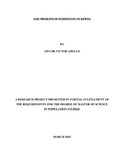| dc.description.abstract | Since their introduction, migration model schedules have become firmly established as an important part of the toolbox of methods for the analysis of migration age patterns. Empirical regularities in age pattern characterize observed migration schedules in ways that are no less important than the corresponding well-established regularities in observed fertility or mortality schedules.
The study focused on whether the patterns and consequences of internal migration and national population redistribution experienced by all nations were similar worldwide. Looking at observable regularities in age pattern exhibited by origin-destination specific rates of migration, the study sought to respond to the need of finding out whether such regularities hold all over the world taking into consideration that similar studies had mostly focused on developed nations. This study was motivated by two research questions: do age profiles of migrants in Kenya exhibit regularities as captured by the model migration schedule? Can summary measures and parameter estimates of the model migration schedules be graduated from observed Kenyan migration data for comparative analysis?
To answer these questions, transition-type data derived from census questions on migration were used to calculate out-migration probabilities for all the regions. The Model Migration Schedule was fitted in Microsoft Excel workbook in four steps. Subsequently, the study went further to illustrate the opportunities presented by the model migration schedules and how demographers could take advantage of them.
The study adopted the most commonly found schedule; the 7- parameter standard schedule, which comprises of three components: a constant, a negative exponential curve representing the pre-labor force ages, and a double exponential (unimodal) curve representing the labor force ages. The migration probability curve as observed from the Kenyan out-migration regional schedules is slightly high during infancy, and becomes extremely low during the ages of compulsory education, sharply rises after compulsory education has been completed, reaching the highest peak between the ages of 14 and 24, and gradually declines thereafter.
It seems evident, in consequence that the multiple parameter model migration schedule, attempts to describe the regularities in age profile exhibited by internal regional out-migration flows in Kenya. | en_US |



